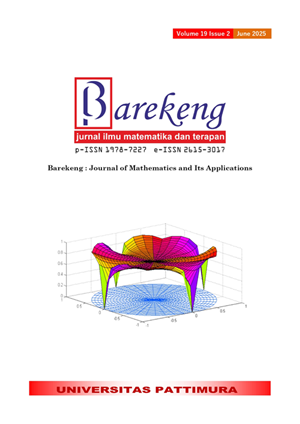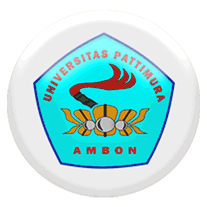THE INFLUENCE OF MODERATING FACTORS IN STUNTING: LOGISTIC PATH ANALYSIS OF ORDINAL DATA
Abstract
Logistic path analysis is used to analyze direct and indirect causal relationships between exogenous-endogenous variables with categorical data types. This study aims to apply logistic path analysis to ordinal categorical data and model the relationship between exogenous variables that affect nutritional status and physical status (stunting) in toddlers in Sumberputih Village, Wajak District. The data used is secondary data obtained from the results of filling out questionnaires in Sumberputih Village at the time of data collection in 2022-2023. The sample used in the study was 100 housewives who had toddlers. The sampling technique used was judgment sampling. However, the study only selected the variables of Birth Weight, Dietary Habits, Nutritional Status, and Physical Status (Stunting). The result of this study is that the variable of Birth Weight has a significant direct effect on Nutritional Status. The variable of Birth Weight has an indirect effect, and the total effect on Physical Status (Stunting) mediated by Nutritional Status is not significant. Meanwhile, the Diet variable has a significant direct effect on Physical Status. In addition, the Socioeconomic Condition variable can moderate the relationship between the Birth Weight variable and Physical Status. The diversity of data that can be explained by the model is 80.36%, while the rest is explained by other variables outside the model by 19.64%.
Downloads
References
E. Nuryuliyani, “MENGENAL LEBIH JAUH TENTANG STUNTING,” Kemenkes Direktorat Jenderal Pelayanan Kesehatan.
F. Siddiqui, R. A. Salam, Z. S. Lassi, and J. K. Das, “THE INTERTWINED RELATIONSHIP BETWEEN MALNUTRITION AND POVERTY,” Front Public Health, vol. 8, p. 453, 2020.
Y. Yusriadi, S. Sugiharti, Y. M. Ginting, G. Sandra, and A. Zarina, “PREVENTING STUNTING IN RURAL INDONESIA: A COMMUNITY-BASED PERSPECTIVE,” African Journal of Food, Agriculture, Nutrition and Development, vol. 24, no. 9, pp. 24470–24491, 2024, doi: 10.18697/ajfand.134.24820.
C. Bommer, S. Vollmer, and S. V. Subramanian, “HOW SOCIOECONOMIC STATUS MODERATES THE STUNTING-AGE RELATIONSHIP IN LOW-INCOME AND MIDDLE-INCOME COUNTRIES,” BMJ Glob Health, vol. 4, no. 1, Feb. 2019, doi: 10.1136/bmjgh-2018-001175.
Kementerian Sekretariat Negara RI, “STRATEGI NASIONAL PERCEPATAN PENCEGAHAN ANAK KERDIL (STUNTING),” Stranas Stunting.
D. Sharma, “ACHIEVING SUSTAINABLE DEVELOPMENT NUTRITION TARGETS: THE CHALLENGE FOR SOUTH ASIA,” Jun. 01, 2020, University of Edinburgh. doi: 10.7189/jogh.10.010303.
T. Siswati, S. Iskandar, N. Pramestuti, J. Raharjo, A. Kharmayana Rubaya, and B. S. Wiratama, “LETTER TO THE EDITOR CAN THE TARGET OF 40% STUNTING REDUCTION BY 2024 BE REACHED? Dear Editor-in-Chief,” 2022. [Online]. Available: https://creativecommons.org/licenses/by-nc/4.0/
A. Prasetyo, N. Noviana, W. Rosdiana, M. A. Anwar, B. P. Harwijayanti, and M. Fahlevi, “STUNTING CONVERGENCE MANAGEMENT FRAMEWORK THROUGH SYSTEM INTEGRATION BASED ON REGIONAL SERVICE GOVERNANCE,” Sustainability, vol. 15, no. 3, p. 1821, 2023.
Databooks Katadata, “PREVALENSI STUNTING BALITA INDONESIA TERTINGGI KE-2 DI ASIA TENGGARA,” Databooks Katadata.
Kementerian PPN/ Bappenas., “PEDOMAN PELAKSANAAN INTERVENSI PENURUNAN STUNTING TERINTEGRASI DI KABUPATEN/KOTA. RENCANA AKSI NASIONAL DALAM RANGKA PENURUNAN STUNTING: REMBUK STUNTING,” Oct. 2018.
A. A. R. Fernandes and Solimun, MENELISIK FAKTOR-FAKTOR PENYEBAB STUNTING PADA ANAK DI KECAMATAN WAJAK: INTEGRASI CLUSTER DENGAN PATH ANALYSIS DENGAN PENDEKATAN STATISTIKA DAN SAINS DATA. 2023.
E. Yammine and A. Rammal, “PATH ANALYSIS TO ASSESS SOCIO-ECONOMIC AND MITIGATION MEASURE DETERMINANTS FOR DAILY CORONAVIRUS INFECTIONS,” Int J Environ Res Public Health, vol. 18, no. 19, Oct. 2021, doi: 10.3390/ijerph181910071.
S. Valenzuela and I. Bachmann, “PATH ANALYSIS,” in The International Encyclopedia of Communication Research Methods, Wiley, 2017, pp. 1–9. doi: 10.1002/9781118901731.iecrm0181.
M. F. Hidayat, R. F. Adji Achmad, and Solimun, “ESTIMATION OF TRUNCATED SPLINE FUNCTION IN NON-PARAMETRIC PATH ANALYSIS BASED ON WEIGHTED LEAST SQUARE (WLS),” in IOP Conference Series: Materials Science and Engineering, Institute of Physics Publishing, Jul. 2019. doi: 10.1088/1757-899X/546/5/052027.
Solimun, A. A. R. Fernandes, and Nurjannah, METODE STATISTIKA MULTIVARIAT PEMODELAN PERSAMAAN STRUKTURAL (SEM) PENDEKATAN WarpPLS. Malang: UB Press, 2017.
D. G. R. Menufandu, R. Fitriani, and E. Sumarminingsih, “ESTIMATION OF MAXIMUM LIKELIHOOD WEIGHTED LOGISTIC REGRESSION USING GENETIC ALGORITHM (CASE STUDY: INDIVIDUAL WORK STATUS IN MALANG CITY),” BAREKENG: Jurnal Ilmu Matematika dan Terapan, vol. 17, no. 1, pp. 0487–0494, Apr. 2023, doi: 10.30598/barekengvol17iss1pp0487-0494.
A. A. R. Fernandes and I. M. Taba, “WELDING TECHNOLOGY AS THE MODERATION VARIABLE IN THE RELATIONSHIPS BETWEEN GOVERNMENT POLICY AND QUALITY OF HUMAN RESOURCES AND WORKFORCE COMPETITIVENESS,” Journal of Science and Technology Policy Management, vol. 10, pp. 58–72, 2019.
I. Picauly et al., “PATH ANALYSIS MODEL FOR PREVENTING STUNTING IN DRYLAND AREA ISLAND EAST NUSA TENGGARA PROVINCE, INDONESIA,” National Library of Medicine, vol. 18, no. 11, 2023.
N. Nuryasmin, “ANALISIS JALUR PADA DATA KATEGORIK,” Brawijaya University, Malang, 2020.
M. Fariyanda and O. Darnius, “STRUCTURAL EQUATION MODELLING (SEM) METHOD IN THE ANALYSIS OF AFFECTING FACTORS STUDENT ACHIEVEMENT WITH THE SYSTEM LEARNING ONLINE,” JMEA : Journal of Mathematics Education and Application, vol. 2, no. 1, Feb. 2023, doi: 10.30596/jmea.v2i1.12472.
J. F. Hair, W. C. Black, and B. J. Babin, MULTIVARIATE DATA ANALYSIS (7th ed.). Upper Saddle River: Prentice Hall, 2009.
L. Fahrmeir and T. Gerhard, MULTIVARIATE STATISTICAL MODELLING BASED ON GENERALIZED LINEAR MODELS. New York: John and Sons, 1994.
A. A. R. Fernandes and Solimun, “MODERATING EFFECTS ORIENTATION AND INNOVATION STRATEGY ON THE EFFECT OF UNCERTAINTY ON THE PERFORMANCE OF BUSINESS ENVIRONMENT,” International Journal of Law and Management, vol. 59, no. 6, pp. 1211–1219, 2017.
A. Agresti, CATEGORICAL DATA ANALYSIS. John Wiley dan Sons. Inc., Publication, 2002.
W. Yanti Sihotang et al., “DETERMINANTS OF STUNTING IN CHILDREN UNDER FIVE: A SCOPING REVIEW,” 2023.
B. Li, X. Tang, and G. Le, “DIETARY HABITS AND METABOLIC HEALTH,” Sep. 01, 2023, Multidisciplinary Digital Publishing Institute (MDPI). doi: 10.3390/nu15183975.
Permenkes RI Nomor 2, “PERATURAN MENTERI KESEHATAN REPUBLIK INDONESIA NOMOR 2 TAHUN 2020 TENTANG STANDAR ANTROPOMETRI ANAK INDONESIA.”
R. Ginting, E. Girsang, M. Sinaga, and P. Manalu, “BARRIERS TO STUNTING INTERVENTION AT A COMMUNITY HEALTH CENTER: A QUALITATIVE STUDY,” Jurnal Penelitian Pendidikan IPA, vol. 9, no. 10, pp. 8185–8191, Oct. 2023, doi: 10.29303/jppipa.v9i10.4656.
P. Jurnal Kesehatan Masyarakat et al., “PENGARUH SOSIAL EKONOMI DENGAN KEJADIAN STUNTING PADA BALITA DI DESA KUALU TAMBANG KAMPAR,” vol. 4, no. 1, 2020.
I. M. Rahma and M. Mutalazimah, “CORRELATION BETWEEN FAMILY INCOME AND STUNTING AMONG TODDLERS IN INDONESIA: A CRITICAL REVIEW,” International Conference on Health and Well-Being, pp. 78–86, 2022.
S. D. Wahyuni, B. Murti, and R. B. Adriani, “META ANALYSIS: EFFECTS OF HOUSEHOLD SIZE, MATERNAL EDUCATION, AND FAMILY INCOME ON STUNTING,” Journal of Epidemiology and Public Health, vol. 8, no. 3, pp. 323–334, 2023.
Copyright (c) 2025 Shalsa Amalia Yulianto, Solimun Solimun, Achmad Efendi, Adji Achmad Rinaldo Fernandes

This work is licensed under a Creative Commons Attribution-ShareAlike 4.0 International License.
Authors who publish with this Journal agree to the following terms:
- Author retain copyright and grant the journal right of first publication with the work simultaneously licensed under a creative commons attribution license that allow others to share the work within an acknowledgement of the work’s authorship and initial publication of this journal.
- Authors are able to enter into separate, additional contractual arrangement for the non-exclusive distribution of the journal’s published version of the work (e.g. acknowledgement of its initial publication in this journal).
- Authors are permitted and encouraged to post their work online (e.g. in institutional repositories or on their websites) prior to and during the submission process, as it can lead to productive exchanges, as well as earlier and greater citation of published works.






1.gif)



